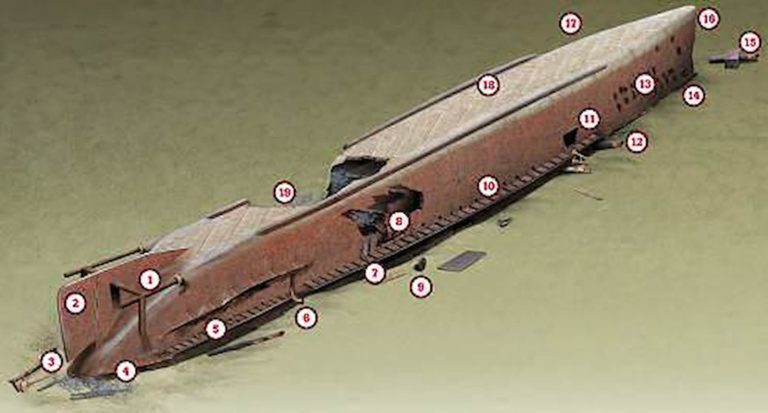A real piece of history, this semi-deep wreck was once a landmark in battleship design – yet she was sunk deliberately just before WW1. JOHN LIDDIARD conducts the underwater tour. Illustration by MAX ELLIS
I HAVE A BIT OF A SOFT SPOT for Royal Sovereign-class vessels. Built in the early 1890s, they were the first battleships of the Royal Navy that hinted at the shape of a modern battleship. At the time they were the largest warships ever built, displacing 15,585 tons, and, like HMS Warrior 20 years before, they made all other battleships obsolete.
The Empress of India was the second of eight ships in the class. On the first seven, the main armament of four 13.5in guns was mounted on two armoured barbettes. The last ship in the class, HMS Hood (Wreck Tour 7, September 1999), was substantially modified, with the fore and aft decks lowered to allow the guns to be mounted in fully armoured turrets.
Secondary armament on all ships consisted of ten 6in guns mounted five a side.
Lessons learned from these ships resulted in the design being revised for the following Majestic class, where the best features of turrets and barbettes were combined into what would become recognised as the ‘modern’ battleship turret.
Nine Majestics were built, making it the most prolific class of battleship ever constructed for the Royal Navy. A similar configuration was subsequently developed over another 20 RN battleships across a number of classes, and further ships were exported to Japan.
Then, in 1906 another leap in design produced HMS Dreadnought – and 25 years of Sovereigns, Majestics and their relatives were rendered obsolete.
Most of the Royal Sovereigns were scrapped before World War One. In 1913, the Empress of India was used as a gunnery target and finally, in 1914, the Hood was sunk as a blockship in Portland harbour.
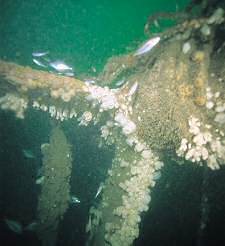
Sometimes I challenge skippers with difficult requests; for the Empress of India, I wanted the shot to be as close to the stern as possible. Rising to the challenge, Doug Lanfear took his time to get the shot hooked in nicely over the port propeller shaft at 35m, so that’s where our tour of the Empress of India begins (1).
Travelling aft from the propeller shaft, the huge rudder is intact and perfectly in line with the keel (2).
Battleships have a habit of turning over when sinking, and the Empress of India is almost inverted, the port side being slightly higher from the seabed than the starboard side.
There is little point staying on top of the wreck, and most of our tour from here on is along the seabed, the stern being at 46m (3).
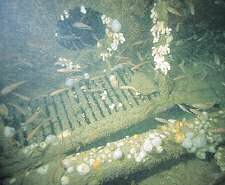
Now working forward along the port side, there is a split from the base of the rudder running round the stern where the wreck has settled (4). A little further forward, the grill of a catwalk protrudes from the hull.
A couple of metres “below” the catwalk there is another long split, where the hull has folded out slightly (5).
The split ends and there is a gap in the catwalk where a boat davit is attached to the outside of the hull (6). Then the catwalk resumes and continues forward for most of the length of the ship (7). The angle of the wreck changes a little from here forwards, leaving more of the hull “above” the catwalk accessible.
About a third of the way forward, the wreck has been cracked open (8) to salvage the condensers. It would be easy to swim past this if you are looking at the holes and fittings further towards the seabed, so a good indication is the partly broken casing of a cylindrical steel buoy resting on the seabed (9).
I suspect that this has nothing to do with the original ship and was left behind by the salvage team.
Even if you’re not into serious wreck penetration, it’s worth having a look round the edges of the salvage hole from the outside. It’s hard to appreciate just how massive 12in-thick slabs of armour are until you see them edge-on.
Anyone who has ventured inside the Hood will be familiar with the galleries that run along the inside of the hull, behind and below the casemates for the secondary guns. It will come as little surprise to learn that there are similar galleries along the Empress of India, complete with open portholes, accessible by entering the salvage hole and exploring forwards. Having said that, such exploration carries considerable risk of silting, collapse and entrapment, and should not be undertaken lightly.
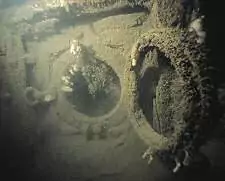
A saner route forwards is to continue level with the catwalk, where the portholes can be seen from the outside (10). Almost at the end of the catwalk, a hole in the hull marks another way into the gallery that runs below the gun casemates (11).
Close to the seabed, a small derrick protrudes ‘above’ the catwalk. Pay careful attention to the hull and seabed here, because just forward of the derrick one of the secondary 6in guns lies half-buried (12).
Venturing between the deck and the seabed here leads you to the base of one of the main gun barbettes, but sadly the guns are not there. Main guns from the Royal Sovereigns were removed to arm floating artillery monitors. Now forward of the armoured part of the hull, the structure is weaker and quite a few small holes have rotted in the side of the bow (13). Then, right at the bow, an oval-shaped hole with a solid perimeter marks the outside end of one of the anchor hawse pipes (14).
The depth is scoured down to 48m, with a section of mast sloping away slightly to port (15).
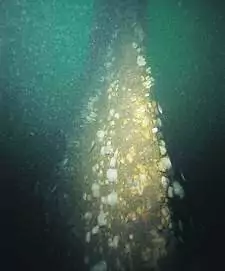
As with most intact wrecks in good visibility, looking upwards before ascending at the tip of the bow is an impressive sight. You will see the coating of anemones and dead men’s fingers, and perhaps shoals of fish swirling in the current (16).
With any time remaining at 35m, swimming back along the hull reveals that hull plates are laid diagonally (17) rather than directly across the hull, though I’m afraid I don’t have an explanation for the engineering benefit of this.
A little further aft, bilge keels run along either side (18), added to the original Royal Sovereign design to improve stability. Then finally, back at the holes broken to salvage the condensers, you’ll note that the hole on the starboard side is considerably larger (19). For those who like to look for recognisable bits of machinery, it offers much more scope than the smaller hole on the port side (8), though with the starboard side of the wreck sunk further into the seabed there is less to see elsewhere along the hull.
So having covered the fate of the Royal Sovereigns, what happened to the Majestics and the other pre-Dreadnoughts?
HMS Formidable was torpedoed further out in Lyme Bay and rests inverted in 60m. It’s a war grave, and diving is now prohibited. Majestic, Irresistible, Ocean, Triumph and Goliath were sunk in the Dardanelles while supporting the Gallipoli campaign. Diving reports are that they have been extensively salvaged and dispersed.
With diving on the Hood now prohibited by Portland Harbour authority, the Empress of India is the last chance for divers to appreciate this landmark stage of battleship design.
With thanks to Doug Lanfear and Andrew Theunissen.
HOLED BY HER OWN SHELLS
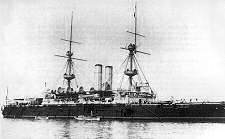
She was massive, and still is. She was a big battleship with big guns. Some of her armour plate was more than 17in thick. But it was a good job she never went to war.
She was built in Pembroke Dock as one of the Royal Sovereign class of battleships and named Renown. However, in 1890 during her building she was renamed Empress of India and was completed under that name in May, 1891, writes Kendall McDonald.
The 14,150 ton Empress was 380ft long with a beam of 75ft, and was armed with four 13.5in, ten 6in and 16 six-pounder guns, and seven torpedo tubes. Twin screws driven by triple-expansion engines and eight boilers drove her along, but even early on there was some discontent with her performance.
That discontent was undoubtedly the main reason why she was selected as the target for gunnery exercises in early November, 1913. She was also reckoned to be pretty near obsolete. So she was towed into Devon’s Lyme Bay for gunnery tests.
Before this, her propellers had been removed and other more portable fittings stripped off her.
The shoot was expected to take some hours, as the Empress of India was protected by a belt of mild-steel armour plate which varied in thickness from 5 to 17in. Fired at with her own shells, by guns of similar calibre mounted in Dreadnoughts, she didn’t last long.
A shell from one of the smaller ships set her on fire. Then one of the first salvoes from a Dreadnought smashed a hole below her waterline. Her armour plate did not extend down there, and she promptly turned over and sank. Everyone seems to have been quite surprised by this swift end to their gunnery.
She landed upside-down on the seabed, and some salvage was soon carried out by a Jersey company which owns the rights. The big hole in her side was made not by the shell that sank her, but by salvage divers blowing out a condenser.
FACT FILE
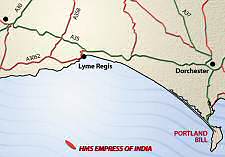
GETTING THERE: Leave the M5 at Junction 25 (Taunton) and take the A358 past Chard to Axminster, then the A35 and B3165 to Lyme Regis, and follow the signs to the Cobb.
TIDES: Slack water is five hours after high water Plymouth and two hours before high water Plymouth.
HOW TO FIND IT: The Empress of India lies with its bows in a south-easterly direction, GPS position 50 29.70N, 2 57.90W (degrees, minutes and decimals). This far offshore there are no convenient transits, so you have to search with a GPS and echo-sounder.
DIVING & AIR : Blue Turtle, skipper Doug Lanfear, 01297 34892 / 07970 856822, UK Directory Professional Charter Boats Website.
LAUNCHING : RIBs can be launched in the harbour at Lyme Regis.
ACCOMMODATION: See Lyme Regis Accommodation Page
QUALIFICATIONS: The Empress of India is an advanced dive and, while being within air limits, is best dived on trimix with nitrox for decompression.
FURTHER INFORMATION: Admiralty Chart 3315, Berry Head to Bill of Portland. Ordnance Survey Map 193, Taunton & Lyme Regis. Dive South Devon by Kendall McDonald. Lyme Regis tourist information www.lymeregis.com and www.lymeregistourism.com
PROS: The last chance for divers to appreciate this landmark stage of battleship design.
CONS: You get to spend most of the dive on the seabed at 46m.
